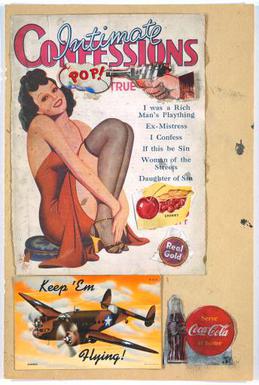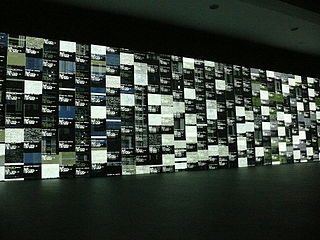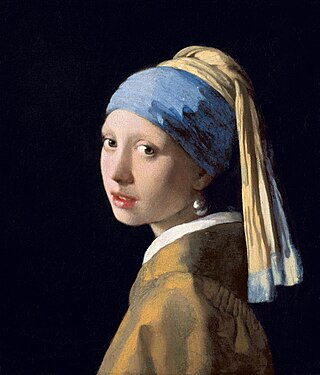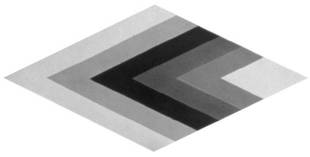Related Research Articles

Pop art is an art movement that emerged in the United Kingdom and the United States during the mid- to late-1950s. The movement presented a challenge to traditions of fine art by including imagery from popular and mass culture, such as advertising, comic books and mundane mass-produced objects. One of its aims is to use images of popular culture in art, emphasizing the banal or kitschy elements of any culture, most often through the use of irony. It is also associated with the artists' use of mechanical means of reproduction or rendering techniques. In pop art, material is sometimes visually removed from its known context, isolated, or combined with unrelated material.

Postmodern art is a body of art movements that sought to contradict some aspects of modernism or some aspects that emerged or developed in its aftermath. In general, movements such as intermedia, installation art, conceptual art and multimedia, particularly involving video are described as postmodern.

Monochromatic painting has played a significant role in modern and contemporary Western visual art, originating with the early 20th-century European avant-gardes. Artists have explored the non-representational potential of a single color, investigating shifts in value, diversity of texture, and formal nuances as a means of emotional expression, visual investigation into the inherent properties of painting, as well as a starting point for conceptual works. Ranging from geometric abstraction in a variety of mediums to non-representational gestural painting, monochromatic works continue to be an important influence in contemporary art.
Minimal music is a form of art music or other compositional practice that employs limited or minimal musical materials. Prominent features of minimalist music include repetitive patterns or pulses, steady drones, consonant harmony, and reiteration of musical phrases or smaller units. It may include features such as phase shifting, resulting in what is termed phase music, or process techniques that follow strict rules, usually described as process music. The approach is marked by a non-narrative, non-teleological, and non-representational approach, and calls attention to the activity of listening by focusing on the internal processes of the music.
Art fabrication describes the process or service of producing large or technically difficult artworks through entities and resources beyond an individual artist's studio. When artists or designers are incapable or choose not to realize their designs or conceptions, they may enlist the assistance of an art fabrication company. Typically, an art fabrication company has access to the resources, specialized machinery and technologies, and labor necessary to execute particularly complex projects. According to a 2018 New York Times article, art fabricators have taken on a greater importance in recent years, as art schools have emphasized ideas and concepts over execution and contemporary artists become less present in their own work.

John Harvey McCracken was an American minimalist visual artist. He lived and worked in Los Angeles, Santa Fe, New Mexico, and New York.

The history of Western painting represents a continuous, though disrupted, tradition from antiquity until the present time. Until the mid-19th century it was primarily concerned with representational and traditional modes of production, after which time more modern, abstract and conceptual forms gained favor.
In the visual arts, late modernism encompasses the overall production of most recent art made between the aftermath of World War II and the early years of the 21st century. The terminology often points to similarities between late modernism and postmodernism, although there are differences. The predominant term for art produced since the 1950s is contemporary art. Not all art labelled as contemporary art is modernist or post-modern, and the broader term encompasses both artists who continue to work in modern and late modernist traditions, as well as artists who reject modernism for post-modernism or other reasons. Arthur Danto argues explicitly in After the End of Art that contemporaneity was the broader term, and that postmodern objects represent a subsector of the contemporary movement which replaced modernity and modernism, while other notable critics: Hilton Kramer, Robert C. Morgan, Kirk Varnedoe, Jean-François Lyotard and others have argued that postmodern objects are at best relative to modernist works.

Funk art is an American art movement that was a reaction against the nonobjectivity of abstract expressionism. An anti-establishment movement, Funk art brought figuration back as subject matter in painting again rather than limiting itself to the non-figurative, abstract forms that abstract expressionists such as Jackson Pollock and Mark Rothko were depicting. The movement's name was derived from the jazz musical term "funky", describing the passionate, sensuous, and quirky. During the 1920s, jazz was thought of as very basic, unsophisticated music, and many people believed Funk was an unrefined style of art as well. The term funk also had negative connotations because the word had an association with a foul odor. Throughout the 1960s and 1970s, Funk was a popular art form, mainly in California's Bay Area in the United States. Although discussed as a cohesive movement, Funk artists did not feel as if they belonged to a collective art style or group. This is because while its artists shared the same attitudes and created similar works, they were not necessarily working together.

De Wain Valentine was an American minimalist sculptor who was born in Fort Collins, Colorado. Often associated with the Light and Space movement in the 1960s, he is best known for his minimalist sculptures of translucent glass, fiberglass and cast polyester resin having slick surfaces suggestive of machine made objects. He lived and worked in Gardena, California.

Systems art is art influenced by cybernetics and systems theory, reflecting on natural systems, social systems, and the social signs of the art world itself.
Craig Kauffman was an artist who has exhibited since 1951. Kauffman's primarily abstract paintings and wall relief sculptures are included in over 20 museum collections, including the Museum of Modern Art, the Whitney Museum of American Art, the Tate Modern, the Louisiana Museum of Modern Art, the Art Institute of Chicago, the Los Angeles County Museum of Art, Seattle Art Museum, and the Museum of Contemporary Art, Los Angeles.

20th-century Western painting begins with the heritage of late-19th-century painters Vincent van Gogh, Paul Cézanne, Paul Gauguin, Georges Seurat, Henri de Toulouse-Lautrec, and others who were essential for the development of modern art. At the beginning of the 20th century, Henri Matisse and several other young artists including the pre-cubist Georges Braque, André Derain, Raoul Dufy and Maurice de Vlaminck, revolutionized the Paris art world with "wild", multi-colored, expressive landscapes and figure paintings that the critics called Fauvism. Matisse's second version of The Dance signified a key point in his career and in the development of modern painting. It reflected Matisse's incipient fascination with primitive art: the intense warm color of the figures against the cool blue-green background and the rhythmical succession of the dancing nudes convey the feelings of emotional liberation and hedonism.

Light and Space denotes a loosely affiliated art movement related to op art, minimalism and geometric abstraction originating in Southern California in the 1960s and influenced by John McLaughlin. It is characterized by a focus on perceptual phenomena, such as light, volume and scale, and the use of materials such as glass, neon, fluorescent lights, resin and cast acrylic, often forming installations conditioned by the work's surroundings. Whether by directing the flow of natural light, embedding artificial light within objects or architecture, or by playing with light through the use of transparent, translucent or reflective materials, Light and Space artists make the spectator's experience of light and other sensory phenomena under specific conditions the focus of their work. From the movement's inception, artists were incorporating into their work the latest technologies of the Southern California-based engineering and aerospace industries to develop sensuous, light-filled objects. Turrell, who has spread the movement worldwide, summed up its philosophy in saying, "We eat light, drink it in through our skins."

Peter Alexander was an American artist who was part of the Light and Space artistic movement in southern California in the 1960s. He is notable for his resin sculptures from the 1960s and 1970s.

Minimalism describes movements in various forms of art and design, especially Visual art and music, where the work is set out to expose the essence, essentials or identity of a subject through eliminating all non-essential forms, features or concepts. As a specific movement in the arts it is identified with developments in post–World War II Western Art, most strongly with American visual arts in the 1960s and early 1970s. Minimalism is often interpreted as a reaction to abstract expressionism and a bridge to postminimal art practices. Prominent artists associated with this movement include Ad Reinhardt, Nassos Daphnis, Tony Smith, Donald Judd, John McCracken, Agnes Martin, Dan Flavin, Robert Morris, Larry Bell, Anne Truitt, Yves Klein and Frank Stella. Artists themselves have sometimes reacted against the label due to the negative implication of the work being simplistic.

James Georgopoulos is a Greek-American visual artist. Georgopoulos works with painting, sculpture, and video installation to address a relationship between highly skilled production techniques, pop culture, and taboo iconography. His work is in various collections, including the Panavision USA Collection. He lives and works in Venice, California.

Gisela Colon is an American international contemporary artist who has developed a unique vocabulary of Organic Minimalism, breathing lifelike qualities into reductive forms. Operating at the intersection of art and science, Colon is best known for meticulously creating light-activated sculptures through industrial and technological processes. Drawing from aerospace and other scientific realms, Colon utilizes innovative sculptural materials such as carbon fiber and optical materials of the 21st century, to generate her energetic sculptures. Colon's gender-fluid sculptures disrupt the traditional view of the masculine minimal object, by embodying qualities of energy, movement and growth, through a merger of industrial with the organic.
Casper Brindle is an American painter and sculptor living and working in Los Angeles, California. Casper Brindle creates artwork that combines influences from both the light and space and finish fetish movements, as well as elements from Minimalism and Color Field painting. His work has been exhibited in the United States and internationally.
Carlson Baker Arts was an American company that provided custom fabrication and engineering services to artists, architectural firms and commercial companies. Based in Sun Valley, California, the company is most known for its work for artists such as Ellsworth Kelly, Jeff Koons, Christian Moeller, Isamu Noguchi, and Claes Oldenburg / Coosje van Bruggen, among others. The firm was founded by Peter Carlson in 1971, and has been headed by Carlson and John Baker as partners since mid-2010. Fabricators like Carlson Baker assist in producing technically challenging, large-scale industrial, labor-intensive, or otherwise complex artworks beyond the capacities of artists and companies. Their technical services may range from 3D scanning and modeling to advanced machining, milling, and finishing to assembly, shipping, and installation.
References
- ↑ Barron, Stephanie; Bernstein, Sheri; Fort, Ilene Susan (2000). Reading California: Art, Image, and Identity, 1900-2000. University of California Press. pp. 295–. ISBN 9780520227675 . Retrieved 14 October 2017.
- ↑ Atkins, Robert (2013-11-26). ArtSpeak: A Guide to Contemporary Ideas, Movements, and Buzzwords, 1945 to the Present (3rd ed.). Abbeville Press. ISBN 9780789211514.
- ↑ Rivenc, Rachel; Richardson, Emma; Learner, Tom (19–23 September 2011). "The LA Look from start to finish: materials, processes and conservation of works by the finish fetish artists" (PDF). Preprints of ICOM-CC 16th Triennial Conference. Retrieved November 21, 2016.